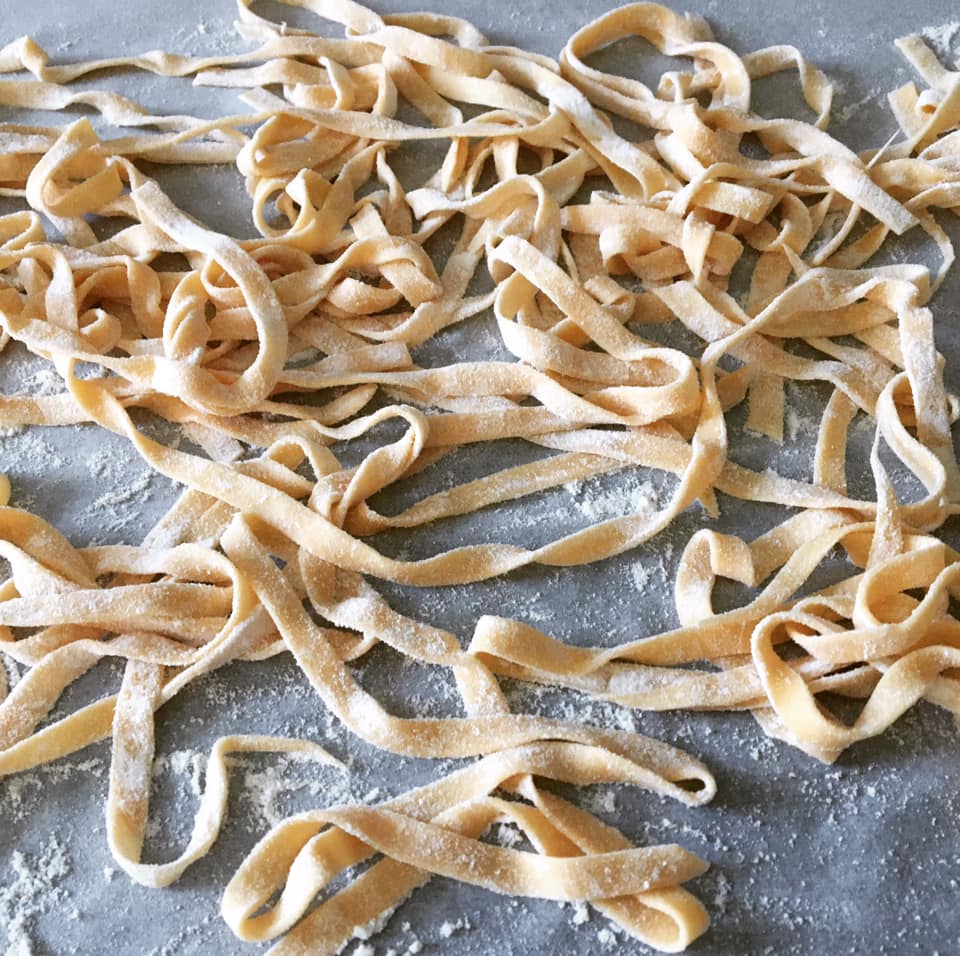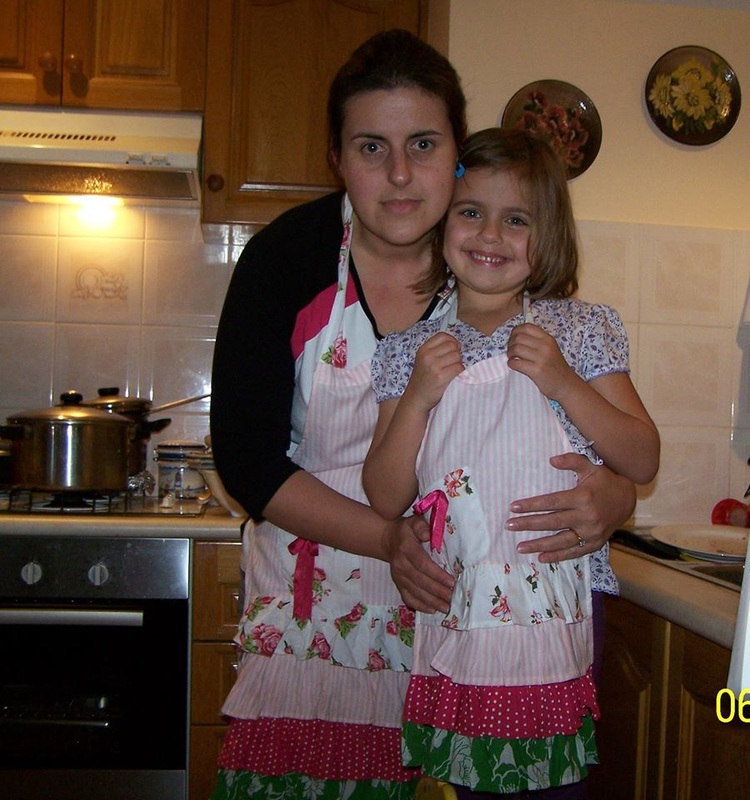Making pasta is far easier than I thought, follow the instructions and you to can make pasta.
The recipe below uses 100g flour, which will make enough pasta for 1 or 2 people. If cooking for more, the quantities are easy to multiply.
Pasta dough with 100g flour + 1 egg will make enough for 1-2 people.
Pasta dough with 200g flour + 2 eggs will make enough for 2-3 people.
Pasta dough with 300g flour + 3 eggs will make enough for 3-4 people.
Pasta dough with 400g flour + 4 eggs will make enough for 4-5 people.
You get the idea.
This recipe is easy and basic and doesn’t change. What does change is the quality of the flour, the size of eggs and the humidity in the air. Don’t panic; what is important is to know what consistency you are trying to achieve, then you can adjust things accordingly. The consistency of the dough should be like playdough – it shouldn’t be too dry or fall apart but it shouldn’t be too wet either or stick to your hands. Hold back the last egg if you are using more than 300g of flour. Check the consistency, then add the final egg slowly yolk first, then the white – if you need it. This should help make sure the dough isn’t too wet.
Don’t be tempted to add too much flour – the more flour you add, the heavier the pasta will be. When flour is added to water it basically turns to glue, so if you add too much flour to the mix, your pasta will become claggy and heavy. This is why, you should always place pasta shapes on a tray with polenta or semolina rather than flour, as it disperses when the pasta is put in the water.
Also use 00 flour, it does make a difference, but you can substitute bread flour if you need to.
Once you’ve cut your pasta shapes, place them on a tray which has a dusting of polenta (as mentioned above). Space them out so that they air-dried a little and don’t stick together. Alternatively, if making long strips of pasta, you can hang them on a clean coat hanger or clothes horse.
Once you’ve cut your pasta shapes, if you make more pasta than you want to use (I like to cook 100g of pasta per person), leave it to air dry for 2-3 days and once completely dry it will keep in a bag or jar for several months.
So if you are interested in making pasta, give this recipe a go, it's delicious.
Recipe
Serves 1-2
100g Tipo 00 flour, plus extra, if needed
1 medium egg
fine salt
1 teaspoon olive oil, if needed
Place the flour on a board or on your kitchen bench and make a well in the centre.
Crack the egg into the well, add a pinch of salt then with a fork, mix the egg into the flour as much as possible so it’s not sticky. Don’t worry if there are lumps in the dough. Keep mixing and then when crumbs form put it on a flat surface and knead together. You can also speed this up by mixing your ingredients in a food processor until they bind.
Once it is all combined, knead until you have a silky, smooth, elastic dough. You are aiming to achieve a playdough texture. If your dough is crumbly (too dry) add a teaspoon of olive oil. If the dough sticks to your hands (too wet) add a little extra flour.
Cover with cling film and rest for 30 minutes at room temperature.
When using a pasta roller, take a tennis ball-sized amount of dough, squash it flat with your fingers (remember to keep the rest of your dough covered with the cling film so it doesn’t go dry and crusty) push it through the pasta roller on the widest setting. Fold into thirds, then repeat 3 times. Once you have a rough square shape, start working it through the machine, taking it down one setting at a time, until the thinnest setting. If your pasta is too sticky, it won’t go through smoothly, so add a little flour to each side before you put it through the roller. Try to avoid too much flour – the less you use, the better otherwise your pasta can start to feel heavy and claggy when cooked.
You can also roll the dough by hand using a rolling pin, but make sure you get it as thin as possible.
You will end up with long rectangular sheets of pasta approximately 8-10cm wide and about the thickness of two playing cards. Lightly dust a flat surface with polenta or semolina and lay out the pasta sheets.
From these sheets you can create different shapes of pasta: lasagne, linguine, tagliatelle, pappardelle, ravioli, tortellini, farfalle...
LINGUINE: Sprinkle a little flour over both sides of the pasta sheet and fold it into thirds (short edges together). using a sharp knife, cut into 3mm- wide strips, lengthways. When you unfold the pasta you will have long linguine.
TAGLIATELLE: Sprinkle a little flour over both sides of the pasta sheet and fold it into thirds (short edges together). using a sharp knife, cut into 1cm- wide strips, lengthways. When you unfold the pasta you will have long tagliatelle.
PAPPARDELLE: Sprinkle a little flour over both sides of the pasta sheet and fold it into thirds (short edges together). Trim the long edges straight with a sharp knife, and cut into 2.5cm-wide strips, lengthways. When you unfold the pasta you will have long pappardelle.
FARFALLE: Place your sheet of pasta on a floured surface. Use a pasta cutting wheel or sharp knife to cut your pasta into strips roughly 3-4 cm wide then cut across to create little rectangles. Take each rectangle and with lightly floured fingers, pinch in the middle to create your butterfly shaped pasta. If your pasta is too dry, wet your fingertips with some water. Lightly dust a few trays with polenta or semolina to prevent the farfalle from sticking together. Place the farfalle onto the trays and repeat the process until you have used all the remaining dough. Leave to dry for 20 minutes so they hold their shape when cooking.
To cook it: Cook in a large pot of boiling salted water. Fresh pasta takes considerably less time to cook than dried, usually 1 to 3 minutes, so watch it carefully. To test, remove a noodle with tongs or a long-handled fork and take a bite.
Serve with your favourite sauce.
Pin it: https://www.pinterest.com.au/pin/399413060705947455


 RSS Feed
RSS Feed